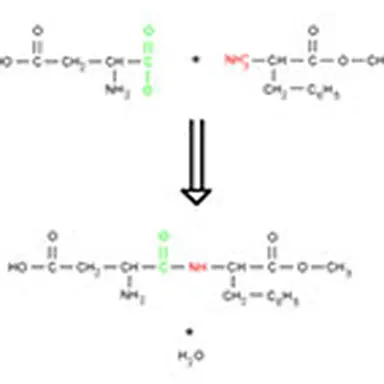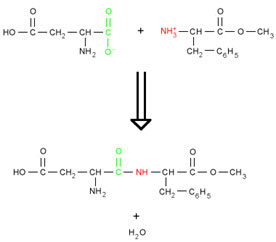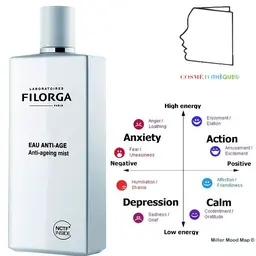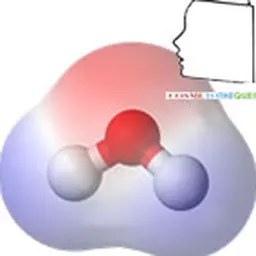
Biochemistry is the scientific discipline that studies chemical reactions that take place within living organisms and therefore within cells. Carl Neuberg is credited with creating this term in 1903 from the Greek root ί (biochēmeia), i.e. as the chemistry of life, but it was a word that had already been circulating in Europe since the end of the 19th century.
The main categories of molecules studied in biochemistry are carbohydrates, lipids and proteins. These molecules consist mainly of carbon, hydrogen, oxygen and nitrogen. These classes of molecules represent the fundamental elements of cell building and functioning. Peptides are one of the three main pillars of biochemistry and cover many functional entities. They present some fundamental characteristics like that of being composed essentially of amino acids, these being characterized by the famous peptide bond.

All those who have done a little biochemistry have probably repeated these few mnemonic formulas to infinity, or even ahané to remember the main amino acids:"…". Go grope Lysine But Do The Most Isolated" (Valine - Tryptophan - Lysine - Methionine - Phenylalanine - Leucine - threonine - Isoleucine).
But in our businesses, it is not usual to consider ingredients through the major classes that are lipids, sugars and proteins or peptides. For the latter in particular, it is necessary to specify them more precisely because their functions are often precise. We rarely use proteins without a little more advanced specification.
General knowledge of biochemistry is essential for the study of skin biochemistry. The study of the skin cannot be conceived without that of the large biochemical families. Similarly, the composition of products cannot be imagined without the contribution of these different molecules.
A particular group of these are the substances that combine protein properties and lipid characteristics. These substances are described in different ways: lipoproteins, lipopeptides, lipoamino acids, biopeptides, oligopeptides, growth factors, etc. But the question is: what are they and what are they for? A review of these substances is necessary to fully understand their structure, function, supply and more generally the uses that can be made of them. It therefore seemed useful, necessary and interesting to try to better understand this great class. To do this, we initiate a large thematic dossier Peptides en beauté. It is organised around specific themes.
To approach this family in a more rational way, we separated it into several groups: - Proteins and protein hydrolysates in general. - Products resulting from the condensation of peptides or amino acids and lipids. - Bioactive peptides, i.e. those associated with the regulation or stimulation of specific activities. - Peptides of marine origin.
For each of them, a recognized specialist coordinated the contributions describing more precisely these substances, their characteristics, uses and specificities.
The first two sections deal with amino acid derivatives, the aim of which is less functionally defined. It covers substances that are often similar in nature, but have different characteristics and specific uses. This dossier will be coordinated by Jean-Claude Le Joliff. We will cover classes of substances such as protein hydrolysates, proteins, lipoamino acids or glutamate acyls, or the famous Dilauroyl lysine and a few others, but whose use is more particularly at the level of formulation than functionalization. We will take this opportunity to wink at an atypical researcher who has marked his time, sometimes discussed, but who has made major contributions. I want to talk about Jean Morelle.
The bios active peptides component, commonly called micropeptides, often derived from recent and innovative technologies, will be coordinated by Karl Lintner who is making us the friendship of a new series of contributions. This section will review this approach, combining matrikines, botox like and a whole series of peptides with highly targeted functions since we have many peptide derivatives to cover virtually all skin functions.
Finally, Gilles Bedoux of UBS will discuss the almost inexhaustible source of the sea, and will give an update on its origin.
A better state of the art, i.e. the specialties available to date will complete the whole. This is what this thematic dossier proposes, a true summary of the best state of the art, and entitled:"When proteins are associated with lipids".
Jean-Claude Le Joliff
| A biologist by training, Jean Claude Le Joliff was an R&D man for many years. Successively in charge of R&D, then of Research and Innovation in a large French cosmetics and luxury group, and after an experience of creating a research centre (CERIES), he turned to innovation management. He was also Associate Professor at the University of Versailles Saint Quentin (UVSQ) and remains a lecturer in several specialized courses: ISIPCA, IPIL, ITECH, UBS, UCO, SFC, etc. He is the founder of inn2c, an R&D and Innovation consulting company. Consultant for several international companies, he has actively participated in projects such as Filorga, Aïny, Fareva, and many others. He created the Cosmétothèque®, the industry's first conservatory of crafts and know-how. |












